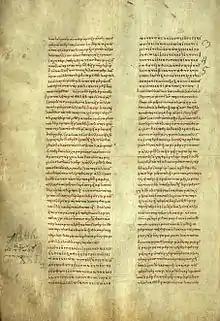Codex Monacensis (X 033)
Codex Monacensis, designated by X or 033 (in the Gregory-Aland numbering of New Testament manuscripts), A3 (in the von Soden numbering of New Testament manuscripts), is a Greek uncial manuscript of the four Gospels written on parchment. The manuscript contains commentary from several church fathers. Using the study of comparative writing styles (palaeography), it has been dated to the 9th or 10th century.[1][2] The manuscript has several gaps, and has been rebound at least once.[1][2]
- "Codex Monacensis" may refer to any manuscript held by the Bavarian State Library.
| New Testament manuscript | |
 Folio 148 verso | |
| Name | Monacensis |
|---|---|
| Sign | X |
| Text | Gospels |
| Date | 9th/10th century |
| Script | Greek |
| Now at | Munich University Library |
| Size | 37.5 cm by 25.5 cm |
| Type | Byzantine text-type |
| Category | V |
It is a witness to the passage of John 7:53-8:11 being omitted.[3]
Description
The manuscript is a codex (precursor to the modern book), containing the text of the four Gospels written on 160 thick parchment leaves (37.5 cm by 25.5 cm) in brown ink.[3] It however has survived in a fragmentary condition, with several leaves from the Gospels of Matthew and Mark missing.[4][2] The text was written in two columns, 45 lines per page,[1] in small, upright uncial letters, by a "very elegant" hand,[4] with breathing marks, accents and some compressed letters.[3] The codex contains the four Gospels in the order of: John, Luke, Mark and Matthew, though the original order was Matthew, John, Luke and Mark, named the "Western Order".[5][3][4] According to Biblical scholar Caspar René Gregory, "The bookbinder messed everything up".[2]
The text of the Gospels contains a patristic commentary (except for Mark) written in minuscule letters.[2][5] The commentary in Matthew and John is from the writings of John Chrysostom, and for some of Luke it is from Pseudo-Titus of Bostra.[3][4] Though most of the commentary in Luke is between the verses, on the reverse side of folio 71 and both sides of folio 72, the commentary (from Origen and other early writers) has been written around the text in later hand to the original.[6]
There are no divisions such as titles (known as τίτλοι / titloi), and the Ammonian sections and Eusebian Canons (both early systems of dividing the Gospels into sections) are absent.[4] The texts of Matthew 16:2b–3 and John 7:53-8:11 are omitted,[2][3] though the Gospel of Mark has the longer ending.
- Contents
- Gospel of Matthew 6:6, 10, 11, 7:1-9:20, 9:34-11:24, 12:9-16:28, 17:14-18:25, 19:22-21:13, 21:28-22:22, 23:27-24:2, 24:23-35, 25:1-30, 26:69-27:12,
- Gospel of John 1:1-3:8, 4:6-5:42, 7:1-13:5, 13:20-15:25, 16:23-end,
- Gospel of Luke 1:1-37, 2:19-3:38, 4:21-10:37, 11:1-18:43, 20:46-end,
- Gospel of Mark 6:46-end (some parts of Mark 14-16 are illegible).[2][4]
Text
The Greek text of this codex is considered a representative of the Byzantine text-type, with occasional readings deemed to be from the Alexandrian text-type. Textual critic Kurt Aland placed it in Category V of his New Testament manuscript classification system.[1] Category V manuscripts are described as "manuscripts with a purely or predominantly Byzantine text."[1]: 336
- Some notable readings
- πας γαρ πυρι αλι αλισθησεται (for everyone shall be seasoned by fire-salt) - X (singular reading)
- πας γαρ πυρι αλισθησεται (for everyone shall be seasoned with fire) - Majority of manuscripts[7]: 121
History
The codex was examined by Joseph Dobrovsky, who collated some of its readings for textual critic Johann Jakob Griesbach.[9][4] Biblical scholar Johann M. A. Scholz collated it again, however the collation was considered poor.[9][4] Biblical scholar Constantin von Tischendorf collated its text again in 1844, and again by biblical scholar Samuel Prideaux Tregelles in 1846. Burgon examined the manuscript in 1872.[2][4]
The codex was held in Innsbruck in 1757. It has been in Rome, Ingolstadt (as a present from Gerard Vossius (1577–1649)), and in 1827 it arrived in Munich.[2][4] The manuscript is currently located in the Munich University Library (fol. 30), in Munich.[1][5][10]
References
- Aland, Kurt; Aland, Barbara (1995). The Text of the New Testament: An Introduction to the Critical Editions and to the Theory and Practice of Modern Textual Criticism. Erroll F. Rhodes (trans.). Grand Rapids: William B. Eerdmans Publishing Company. p. 113. ISBN 978-0-8028-4098-1.
- Gregory, Caspar René (1900). Textkritik des Neuen Testaments. Vol. 1. Leipzig: J.C. Hinrichs. pp. 82–83.
- Hatch, William (1939). The Principal Uncial Manuscripts of the New Testament. Chicago: University of Chicago Press. p. Plate LXXI.
- Scrivener, Frederick Henry Ambrose; Edward Miller (1894). A Plain Introduction to the Criticism of the New Testament. Vol. 1 (4 ed.). London: George Bell & Sons. p. 152.
- Metzger, Bruce Manning; Ehrman, Bart D. (2005). The Text of the New Testament: Its Transmission, Corruption and Restoration (4th ed.). Oxford: Oxford University Press. p. 81. ISBN 0-19-516667-1.
- Vogels, Heinrich Joseph (1929). Codicum Novi Testamenti Specimina: Paginas 51 ex codicibus manuscriptis et 3 ex libris impressis collegit ac phototypice repraesentatas. Bonn: Sumptibus P. Hanstein. p. 6 (Tab. 10).
- Aland, Kurt; Black, Matthew; Martini, Carlo Maria; Metzger, Bruce M.; Wikgren, Allen, eds. (1981). Nestle-Aland Novum Testamentum Graece (26 ed.). Stuttgart: Deutsche Bibelstiftung. ISBN 3-438-051001. (NA26)
- Tischendorf, 8th edition
- An Introduction to the Critical Study and Knowledge of the Holy Scriptures. pp. 195–196.
- "Liste Handschriften". Münster: Institute for New Testament Textual Research. Retrieved 16 March 2013.
External links
- R. Waltz, Codex Monacensis X (033): at the Encyclopedia of Textual Criticism.
- Images of the manuscript online at the CSNTM.
- Cim. 16 (= 2° Cod. ms. 30): Full digital copy at Ludwig Maximillians Universitat Muchen Open Access University Library.